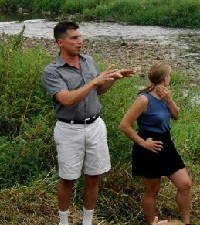
Mark Gutshall, LandStudies, Inc.
|
The bad news is that we’re heading for an ecological catastrophe in the greater Chesapeake Bay watershed. The good news is that if the public and private sectors work together, we might just be able to fix this one.
Mark Gutshall,
LandStudies, Inc. | Partnership is the current buzz word when it comes to saving the Chesapeake Bay. Governors from Pennsylvania, Maryland, and Virginia recently announced plans to launch a combined lobbying effort designed to convince the federal government to help them fund a $15 billion Bay clean up by 2010 on an 80-20 basis (80 percent of the funds from the federal government, 20 percent from the cash-strapped states).
Pennsylvania Governor Ed Rendell even promised that the Bay states would partner with states from other regions seeking federal dollars for their own critical environmental needs. The only partnership the governors didn’t highlight, however, was the one that might matter most in the long run – a true public-private initiative.
The private sector typically gets ignored (or even vilified) in most efforts to “Save the Bay,” but the truth is that the number one cause of sedimentation and nutrient pollution in the Chesapeake Bay is not industrial pollution, runoff from development, or modern-day agricultural activities.
The leading cause of degradation in the Bay comes from poor land use practices that were undertaken over one hundred years ago, which created a problem known as “legacy sediments.”
Following the first permanent European settlements at Jamestown, the ecological balance of the region shifted in substantial and often harmful ways. The worst damage was done during the eighteenth and nineteenth centuries when wholesale land clearing for timber and farming set off widespread erosion. Untold tons of soil rich in phosphorus from multiple sources moved downhill to the low-lying stream and river valleys.
The construction of thousands of dams for water-powered mills caused water behind the dams to slow, and the eroded sediments built up behind them. Stream channels and their floodplains subsequently grew higher as nutrient-laden sediments accumulated.
The higher elevation of the floodplain is actually the key to our present-day problems. Most floodplains of the Upper Chesapeake were once at least four to five feet lower than they are today. In areas near old mill dams, the disparity can be 10 feet or higher. As dams have fallen into disrepair or have been removed, stream channels have cut back down toward their historical elevation, but the adjacent floodplains have not.
Streams flowing along straight, high, unvegetated banks are a common sight in the Chesapeake Bay watershed – so common that we believe that’s the way streams should look. Yet those bare banks are composed not of the terrain’s original soils, but instead of polluted legacy sediments that erode into the stream every time rain or snow melt creates a high flow. Root zones on elevated floodplains are too high above groundwater levels to absorb nitrogen compounds from the water, so nitrogen, too, enters the downstream flow.
Channels that have worked their way down toward their earlier elevation can’t release excess water and its energy onto the modern, elevated floodplain. That is why sediments and nutrients have been accumulating in the rivers and streams of the region and literally choking the life out of the Bay.
People fear and detest floods, but nothing could improve the long-term ecology of the Chesapeake Bay better than more regular (and naturally contained) flooding in the Upper Chesapeake region. Floodplains are nature’s buffer zones. Our regional water is being polluted because floodplains are no longer functioning properly.
To clean up the Bay and its tributaries, we need to focus on the land surrounding them. We can do this through a technique that restores both stream channels and their adjacent floodplains. Stream bank stabilization and stream channel restoration are increasingly common practices, but without floodplain restoration, they are merely temporary solutions.
Here is where the private sector can play an essential role.
Corporations, farmers, developers, and others engaged in the marketplace should be encouraged to finance ambitious floodplain restoration projects that would address their regulatory obligations while helping local governments comply with theirs. In return for financing such projects and saving the public sector and the taxpayers up to $15 billion to clean up the Bay, the private sector should receive streamlined permitting and multiple credits toward fulfilling their various discharge requirements.
Political leaders and environmentalists must become more focused on developing such public-private partnerships. More federal dollars are wonderful – if they ever actually arrive. In the meantime, some states such as Pennsylvania do not yet recognize stream corridor and floodplain restoration as a best management practice. They should do so quickly, because developers and municipalities are facing new, tougher federal standards for run-off management.
In addition, other Bay states can build on an experiment that Pennsylvania has wisely initiated which provides nutrient-trading options for sources that discharge into the waterways. Creating a “marketplace” for discharge trading might sound counter-intuitive, but it has worked to help regulate air emissions and could help clean up our water.
The Chesapeake Bay-area governors vowed in January to seek partners anywhere they could find them. They should begin with their own constituents whose livelihoods may depend on economic development in the Chesapeake Bay region, but whose lives still depend on preserving the future health of North America’s largest estuary.
Mark Gutshall is the president of Land Studies, Inc., an award-winning environmental engineering firm based in Lititz, Pennsylvania. Send email to: land@landstudies.com .
|